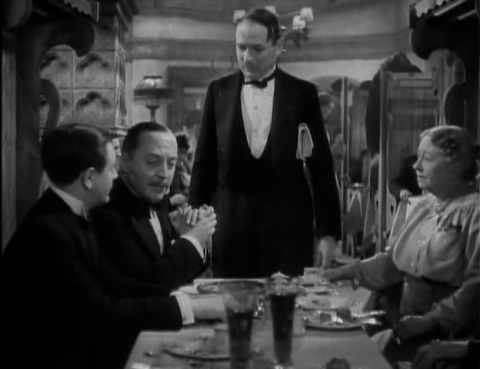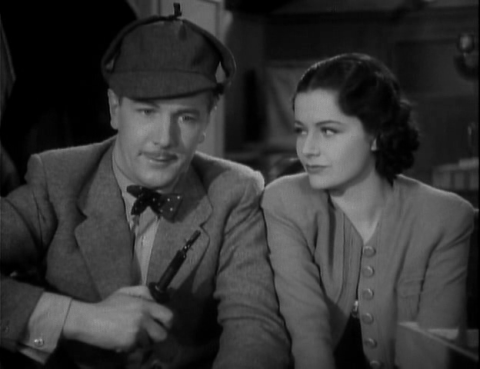It may perhaps seem like constructed languages, such as Star Trek’s Klingon or John Carter’s Barsoomian, have only started to appear in movies and on TV during the past few decades. Sure, a language like Na’vi in Avatar (2009) that was created directly for the movie – with the complexity of a natural language and a large base of fan speakers – that kind of thing has not been seen before Klingon. But Esperanto, originally constructed as a tool for peaceful communication across borders, was used at least as early as the classic silent film Der letzte Mann (1924), and the earliest attempt to create a dedicated language for a movie may have been the subject of this week’s post, namely Hitchcock’s The Lady Vanishes.
The language in question is spoken in the fictional European country which through different sources is variously known as Mandrika, Bandrieke, Vandreka, etc. The film begins at a hotel in a small town where the only train out is delayed by snow.
The language can be heard in many brief dialogues throughout the movie, though without the original script, it is impossible to analyze whether it is actually a complete language with coherent grammar and vocabulary, or just so many nonsense syllables. One of the few sentences which is both easy to make out and easily translated is spoken as “Reinefetado eš fenito.” (We are out of food.) This would seem to vaguely suggest a Romance language, though some sources claim it is a mashup of many different European languages.
Constructed language can serve several different purposes on the silver screen. Often, it is used to provide credibility to a fantasy culture, such as the elves in The Lord of the Rings (2001) or the vampires in Blade (1998). But in The Lady Vanishes, this is not the main reason. Hitchcock could have just as well used an existing language, and an existing country.
The purpose is rather to create ambiguity about the underlying identity of the country. The interesting blog Reel Club has a post about Hitchcock’s political messages in this movie, and how he criticized England’s blindness in the face of the dangerous European situation. (In my opinion, Reel Club is perhaps overinterpreting some aspects, but essentially the reasoning is very good.) From that perspective, it is plain that Bandrika (the most common spelling, I think) is a Germany in disguise, and the Bandrikan language is part of that disguise. The viewer, of course, was supposed to infer as much, but there was no war and Germany could not be pointed out as the enemy just yet.
Over in America, about the same time, several films were released that used Esperanto for the same purpose, including Charlie Chaplin’s The Great Dictator (1939). The technique is similar to that used in e.g. Dark Journey (1937), where the action is moved to a historical period (World War I) in order to provide the necessary setting for the political allegory.
Though far from Hitchcock’s best, The Lady Vanishes is competently made and in many ways a typical and very adorable Hitchcock thriller. Hitchcock’s amazing sense of perspective and focus is seen in a few instances, and as always, the plot holds a good deal of psychological interest. There is also a bit more comic relief than in most Hitchcocks.
This film is best enjoyed by lovers of train thrillers. Hitchcock had an excellent sense of the dramatic possibilities offered by the limited space in a train.
The Lady Vanishes
Download link
Year: 1938
Running time: 1 h 35 min
Director: Alfred Hitchcock
Stars: Margaret Lockwood, Michael Redgrave, Dame May Whitty
Image quality: Good
Resolution: Medium (624×480)
Sound quality: Good
Best file format: MPEG4 (1,017 M)


Great movie. It’s like an imaginary country from the old empire. There is also the codified language of the tune.
The message in the tune is the film’s “MacGuffin”, a plot device which is only important as a means of bringing the main characters together and giving them a common focus. Note that the contents of the message are never revealed, nor even whom it was intended for. See here for more info: http://en.wikipedia.org/wiki/MacGuffin
There is also a written part of Bandrieken, in Doppo’s commercial poster, approximately at 00:57′ of the movie.
Great! I was looking for written signs, but missed that one. There are also signs on board the train, but not sure whether they are in Bandrikan. I will have to look closely some day.
Bandrika is a fictional country, but if we want to piece together the hints from source material (the novel on which it is based, the previous location filming – Yugoslavia) and internal evidence and come up with a hypothetical origin for this undiscovered corner of Europe, somewhere near Trieste, Vienna & Budapest, with mountains and a Balkan dancing tradition, I would guess Slovenia, Julian Alps north west of Bled.
Interesting hypothesis. There are so many fictional European countries in literature and movies, and it is always fun to try to guess the geographic location.